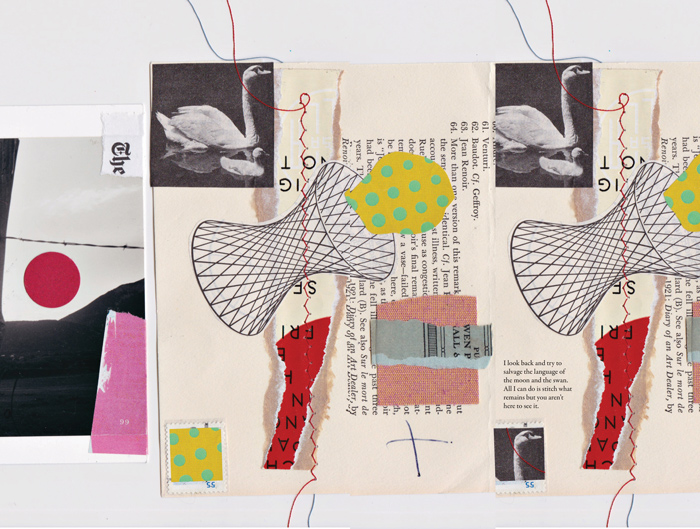
each 4.5”x 6”; two collages with old photo, fabric, pencil, torn book pages; stitched; 2022. Courtesy of the artist.
POETRY & COLLAGE
Kolaj’s History of Poetry & Collage
It says something that in the Poetry Foundation’s Glossary of Poetic Terms, “collage” is one of the few visual art terms they define. Perhaps this is because so many poets have also been collage artists. In recent years, we’ve seen exhibitions from John Ashbery and Marc Strand, whose collage “dates back to his student days at Yale in the 1950s where he studied with Josef Albers, the renowned Bauhaus artist and color theorist, and also Bernard Chaet.” Arthur Solway recalled, “Though we were eight thousand miles apart we would have weekly Skype calls, and he was always eager and excited to show me the latest batch of collages he was working on.” A 2017 book of Helen Adam’s collages, which fellow poet Robert Duncan referred to as “pleasing weird”, has sold out. Keith Waldrop, Barbara Guest, John Wieners, Norma Cole, the list is long.
Poets have routinely appeared in the pages of the printed magazine. Kolaj 30 featured an Artist Portfolio of Denver, Colorado-based poet and English professor Brian Barker. In Kolaj 27, we remembered poet and mail artist Steve Dalachinsky (1946-2019). In Kolaj 24, Brazilian artist Samuel Eller combined visual poetry and process poetry, contemporary collage, and experimental design. Kolaj 13 has an article about the book Flit, Dennis Milam Bensie’s poetry mashups of classic literature.
Online we wrote about an exhibition featuring the work of Mary Jo Bang, “a celebrated poet who, for most of her life, has secretly made artwork.” Karen Green “transitions seamlessly between textual, visual, and back” in her book, Bough Down, which Ariane Fairlie described as “a cross between poetry and art book.” We also wrote about Cecil Touchon’s Quarantine Collage Poetry book, Nuclear Wastes Poetry and Collage zine, and countless others.
In “Where The Sun Casts No Shadow: Postcards from the Creative Crossroads of Quito, Ecuador”, an exhibition that debuted at the Wilson Museum of the Southern Vermont Arts Center in November 2019, the poetry of María Clara Sharupi Jua in Spanish, English, and Shuar hung next to art from Quito’s El Club de Collage. (This exhibition will travel to the Knoxville Museum of Art in Fall 2022). At Kolaj LIVE Milwaukee in 2021, we hosted a session by Renée Reizman on her “Deconstructing Legalese” project where she made found poetry using legal documents. During the Cut It Up Salon in Milwaukee, the participants from Reizman’s session read aloud their found legalese poetry. Clark Lunberry, who is known for his large-scale, site-specific art and poetry installations on water, spoke about turning a collection of postcards inherited from his father into “PostCardPoems“. Readings have also been a part of Kolaj Fest New Orleans, particularly at “Why Is That Dinosaur Holding a Vacuum & Other Stories from the World of Collage” in 2018 and “Collage Party at Art Klub” in 2019 and “Show & Tell” in 2022 that was hosted by writer and collagist Kevin Sampsell who read from his book I Made an Accident.
All this is to say that Kolaj has been circling around the intersection of poetry and collage throughout its history and yet it wasn’t really until Rod T. Boyer’s article in Kolaj 32, “Mind the Gap: Collision and Context in Haiku and Collage“, that we began to appreciate the degree to which these two mediums interacted with each other. In that article Boyer compares the disjunction that occurs in haiku with a similar phenomenon in collage. A light went off and we decided to organize a series of residencies with the goal of exploring the intersection of collage and poetry.
In January 2022, we issued a call to artists for a Poetry & Collage Residency and received so many excellent responses that we organized a series of three residencies. The artists heard from guest speakers Kevin Sampsell, Renée Reizman, Rod T. Boyer, and the Poetry Foundation’s Fred Sasaki and were challenged to create page spreads to be included in a forthcoming book of collage and poetry.
In the residency, we challenged artists to move beyond taxonomical debates. Ric Kasini Kadour said, “What is a poem? We do not need to have a singular answer to that question. Individually we must each answer that question for ourselves. In practice, every poem we make will be an example of what a poem is. In considering other people’s work, we should ask ourselves, How is this a poem?” During the residencies, artists interrogated each other’s artwork, collaborated, and shared ideas. And at the end of it, they sent us more page spreads than could fit into a single book. Impressed and moved by the volume and quality of cultural output and a deep belief that this practice–however you want to describe it–at the intersection of collage and poetry deserves a platform, we decided to create a new journal dedicated to it. Christopher Kurts named it PoetryXCollage and said, “How do you pronounce it? You can say the letter ‘X’ or it can stand for the words ‘and,’ ‘in collaboration with,’ or ‘featuring.’ The X is an intersection, a crossroads, or an equation. X marks the spot.”
PoetryXCollage extends Kolaj Institute’s philosophy that books and publications are natural places for collage, as explored in a 2019 symposium and catalog.
PoetryXCollage soft debuted at Kolaj Fest New Orleans in June 2022 and officially launched July 15, 2022. A third round of the residency will take place in September 2022. In 2023, Kolaj Institute will open up submissions for future volumes of PoetryXCollage.
